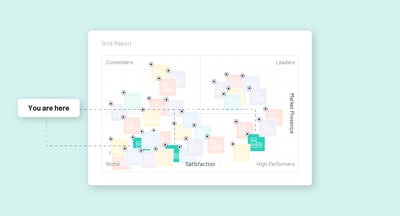September 28, 2022
 by Chris Perrine / September 28, 2022
by Chris Perrine / September 28, 2022

When you only have a hammer, everything looks like a nail.
Imagine owning a stocked toolbox and grabbing a hammer for every job. It does a handful of things very well, but why limit yourself when all those tools can do so much more?
Customer reviews on G2 are a powerful tool for B2B software. They establish your brand as trustworthy and authoritative, and help drive pipeline growth. But most CEOs don’t realize that G2 is an incredible solution for more than just acquiring buyers.
In this guide, you’ll learn why G2 is a valuable addition to the CEO’s toolkit beyond sales and marketing needs.
G2 is where you go for software. Software companies leverage their G2 profiles to collect customer feedback and persuade potential buyers. At the highest level, this is how most folks tend to think about G2.
G2 is the place for B2B software brands to increase their visibility and convert new customers:
B2B software marketers look to G2 for building your brand and driving pipeline, while the sales team focuses on converting buyers.
Acquiring leads and closing deals are the lifeblood of any software company. CEOs need to care about these things, but they mostly care about the bigger picture - to reach the right VCs at the right time for funding.
In the eyes of a CEO, G2’s potential as a tool for research can impact:
CEOs bolster their chances of success in their fundraising efforts by prioritizing a strong presence on G2. Let’s explore how VCs and private equity firms use G2 to see how you can use it to your advantage.
-png.png)
It’s worth mentioning that VCs and private equity firms can use G2 just like software buyers. But most opt to use G2’s Investor Solutions, a more comprehensive tool to analyze our extensive database of software vendors.
G2 is a massive marketplace across countless industries and covers numerous software categories, which is why PE firms and VCs view G2 as a reliable tool for market research.
Imagine the day-to-day of a VC. They scour the world for new opportunities to become early investors. By using customer feedback and third-party, independent research from G2, they can assess strong candidates and engage with start-ups before competing investors get a chance.
A key goal for them is to identify companies that fit their investment criteria and are making strides or significant moves relative to their competitors or within their product categories. Such moves can include:
VCs and private equity firms need more than just a good product and founders they like when researching new investment targets. G2 helps VCs gauge long-term demand by understanding market sentiment about different software.
Once a VC has identified a vendor, they need a bit more qualitative research to dig deeper. A good starting point for them is to ask questions like:
Then comes the hard part for the VC: justifying their investment. We’ve increasingly seen VCs using G2’s data as part of this justification. While review data is essential, it goes well beyond that. VCs and private equity firms will use G2 to source some of the other pieces of crucial market research data, such as:
Considering the kind of impact this research can have, let’s take a look at a few key ways CEOs can extract the most value from G2 to secure more funding.
A good place to start is to ensure that your brand has a fully optimized G2 profile. With this foundation in place, you’ll make it easier for VCs and private equity firms to discover your brand on G2.
The best part of all: there’s no extra cost. What comes with your G2 profile is the same as what your sales and marketing teams use in your current plan. The idea here is to ensure you’re adding as much relevant information about your software as possible and that you’re actively driving customers to submit reviews.
CEOs with a more proactive involvement on G2 see a higher overall ROI. A greater executive focus on their G2 profile typically yields more reviews, which translates to more traffic, brand recognition, and pipeline.
You know just how much VCs and private equity trust in G2 for researching new investment opportunities.
CEOs should use as much data as possible to show why their company is a sound investment for VCs. Citing your profile data and other G2 reports goes a long way in demonstrating the strength of your brand by empowering your customers to be another voice that tells your story.
Consider incorporating G2 data right into your pitch decks and other fundraising materials. There’s a wealth of information at your disposal, so here are a few use cases to explore:
There’s much more to G2 than what it can illustrate about your brand. If you have access to G2 Buyer Intent data, you can find out which accounts are researching your company.
Most use cases for G2 Buyer Intent data are to fuel intent-driven campaigns and account-based marketing (ABM) efforts. However, these insights can reveal more than new prospects.
Our Buyer Intent data can validate which VCs show strong interest in you. You can either get confirmation of ones you’ve already engaged with or identify fresh opportunities and reach out to those VCs discovering you on G2.
Pro tip: Every free G2 profile gets access to 4 buyer intent leads per month at no extra cost. Check out The Buyer Intent Playbook to learn how to get the most from intent data.
There’s more to G2 for CEOs than fundraising efforts. Let’s explore how you can use it for identifying new partnerships, researching new acquisition targets, and attracting the world’s top talent.
Similar to how a VC uses G2 to research vendors, CEOs on the lookout for potential strategic partners should use G2 in the same way. If a vendor has a really strong G2 profile, you’ve likely found yourself a strong match for a new partner.
When you have a sense of the types of vendors you want to engage with, establish criteria that can help you assess which ones make the most sense for your goals. Just like how you would use G2 data to justify your company to a VC, G2 is a powerful research tool to dig into these opportunities.
You want to mutually benefit one another, and a strategic partner has to see the value in the partnership, too. Citing G2 data can signify your track record, especially if you are a start-up or don’t have an extensive history of partnerships. Similarly, you can apply this logic to sourcing and engaging potential channel partners.
Let’s say your product is a comprehensive CRM platform. You want to expand on current capabilities, and a partnership makes the most sense. You seek to partner with a customer success platform so your product can leverage functionalities like surveys and team interactions. The process might look like this:
As vendors continue to mature, many eventually explore opportunities to acquire other companies to expand on their offerings or tap into new audiences. Again, this is a prime use case where G2 can be an essential research tool CEOs need to keep in their back pocket.
You can follow a similar process for sourcing new strategic partnerships where G2 has the data to aid in your search. The key part of this is understanding what criteria you need to qualify target acquisitions, so make sure that you first figure this out.
Keep in mind that G2 is also a useful tool if you are seeking to make your company an acquisition target. Whether you’re looking for new acquisition targets or preparing your company for a potential acquisition, G2 can help accomplish these goals.
Imagine you are the CEO of a marketing automation platform that caters to the non-profit industry. You don’t have the capability to manage and trigger SMS communications, but it makes more sense to acquire a company that can. Here’s one way you should use G2 to find those potential targets.
Much like how buyers will start their research on G2, potential candidates also want to know how a company is performing in the market. In addition to career sites like Indeed, LinkedIn, or Glassdoor, G2 customer reviews show job applicants more than what other employees say about working for a vendor.
Many workers want to understand if customers like a vendor’s offerings and how a company approaches adversity. A strong candidate might have second thoughts about joining your company if reviews consistently complain about bugs or unresponsive customer support.
Top workers want to be a part of teams that have passion for their product and are staunch advocates for their customers. They also want to see how a vendor stacks up against its competitors and assess whether a company will thrive long-term.
You’re on the hunt for a new director of customer success for your ERP software company. You have a strong team in place, but you see an opportunity to bring in an external hire to strengthen things a bit more.
How do you think your top candidates would feel if they saw several reviews like this with no response from your company?
“I used to love this product, but things have been pretty rough in the last few months. On top of a complicated new design, we keep running into certain things not working. Support has been far less than helpful, with response times of 2 weeks or more! Our customer experience contact is a nice guy, but they rarely help us resolve our issues.”
Hammers are perfect for some jobs, but others need a screwdriver or a saw. Customer reviews are just the tip of the iceberg when it comes to how CEOs need to approach G2.
Ready to use G2 to its full potential? Book time with your marketing team and a G2 Specialist to understand how your SaaS product can take off on G2.
Chris Perrine is a seasoned leader and entrepreneur with over 20 years of experience in the Asia Pacific region. Having co-founded Springboard Research and successfully exited to Forrester, he's also helped build IDC, ProductReview.com.au, as well as now leading G2's efforts in the region.
The voice of the customer is indispensable when your product is outstanding.
 by Stephen Hoops
by Stephen Hoops
At full capacity, Madison Square Garden can host more than 20,000 people in its arena.
 by Brittany K. King
by Brittany K. King
Algorithms are like a recipe for a cake. The core ingredients may stay the same, but a great...
 by Sara Rossio
by Sara Rossio
The voice of the customer is indispensable when your product is outstanding.
 by Stephen Hoops
by Stephen Hoops
At full capacity, Madison Square Garden can host more than 20,000 people in its arena.
 by Brittany K. King
by Brittany K. King


